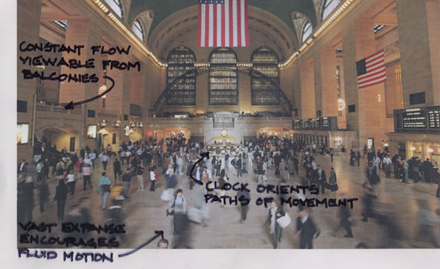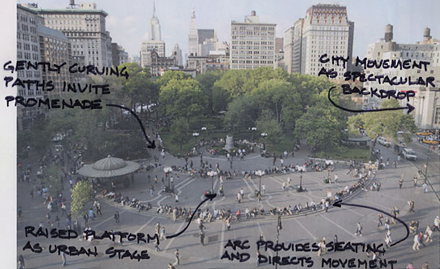The dance of people in public spaces 06 Jul 2006
15 comments Latest by Rugby Fan Steve
Architect and set designer David Rockwell was hired to design the “interior experience” (arrival, departure, retail space) of the new JetBlue terminal being built at JFK Airport (Gensler handled most of the architecture). Looking for a new angle on movement vs. environment, Rockwell took a strange turn: He hired choreographer Jerry Mitchell to help him. At the New JetBlue Terminal, Passengers May Pirouette to Gate 3 examines the collaboration and takes a look at the dance of people in public spaces. There’s also an accompanying audio slide show that looks at the process and its results.
The duo started out by looking at what they considered well choreographed spaces in New York, like the Grand Foyer at Radio City Music Hall, Grand Central Station (top photo), and Union Square (bottom).


After examining the dance at these places, the choreographer urged the terminal’s architects to eliminate crisscrossing and straight edges in favor of a merry-go-round approach since “people move easiest in circles.” He also urged them to recognize the “different emotional experiences” of arrival and departure and treat them accordingly. The resulting design for the terminal can be viewed in the slide show or this PDF.
Here’s more on how it all went down:
So he and the architects looked for ways to alter the shape and pace of passenger movement within the terminal, drawing less on transportation hubs (which are patronized of necessity) and more on urban spaces that people actually choose and enjoy. At Union Square, as Mr. Rockwell explained on a recent tour through some of those sites, the paths are wide enough for pedestrians to move along them in both directions at once, allowing for the pleasure of proximity without discouraging eye contact. (Squeeze people too close, as on a rush-hour subway train, and they won’t look at one another.) The paths are also gently curved, allowing some surprise about what’s around the next bend. And those curves seem to stretch time; as we circulated slowly, we were always aware of how we were deviating from the Manhattan grid, which nevertheless persisted as a faint impression, like a distant drumbeat…
Out of such thoughts, and Mr. Mitchell’s choreographic insights, came the Rockwell Group’s solution for the JetBlue terminal. Various obstructions (principally two large bleacherlike seating areas rising up like icebergs after the security checkpoints) would subtly lead outbound travelers toward the periphery of the space — the longer, more circular route — while inbound travelers would be directed straight between them, down a level and swiftly out. The periphery walls would be curved like the paths at Union Square to slow down the outbound experience and, not incidentally, enhance the likelihood of lingering over merchandise. And the bleacherlike seating areas, improving on the usual pods of wee chairs and tables at floor level, would encourage people to get above the action and watch the shapes of the promenade that they were recently part of.
Inspiration doesn’t always come from obvious people or places. Kudos to Rockwell for seeking solutions under unusual rocks and to Gensler/JetBlue for recognizing the value of this unorthodox approach.
Related: JetBlue’s Terminal Takes Wing [BusinessWeek]
15 comments so far (Jump to latest)
nate 06 Jul 06
Interesting.
I find that people, like gasses, tend to move from an area of higher concentration to an area of lower concentration. This process, known as “diffusion,” appears to occur at both the individual and group levels.
The tertiary result of this process (or perhaps the cause of it?) is that people tend to move as far away from surrounding people and objects, taking up as much space as possible.
Luis 06 Jul 06
We’re all just ants marching to the distant beat of the drum called money and material gains.
Steve Portigal 06 Jul 06
When did Rockwell leave The Rockwell Group and join Gensler?
Bryce 06 Jul 06
I’ve always found the design of public spaces fascinating, especially urban ones, since they’re so different than the designed spaces I’ve been to recently (theme parks and suburban university campuses).
“The tertiary result of this process (or perhaps the cause of it?) is that people tend to move as far away from surrounding people and objects, taking up as much space as possible.”
Only when static does this happen. Given the choice between personal space and getting where they need to go, most travelers will go for the latter. The purpose of the JetBlue terminal’s design is to use subconscious cues to let the foot traffic self-organize into non-turbulent and efficient patterns.
ML 06 Jul 06
When did Rockwell leave The Rockwell Group and join Gensler?
Whoops, the project was a collaboration between Rockwell Group and Gensler (he didn’t leave RG for Gensler). Updated the post so that’s clear.
nate 06 Jul 06
“Given the choice between personal space and getting where they need to go, most travelers will go for the latter.”
Yeah, you would think. Having spent most of the weekend in an airport, I can tell you that this is not univeraslly the case. Granted, the mindset is a bit different from your typical airline “commuter,” but even then…
I take a commuter train to and from work every day, and I’m amazed by the people who simply mill about on their way through, with so little consideration for the people around them who are actually in a hurry.
Personally, I don’t think human beings are basically good or basically evil, but no one will ever convince me that all human beings are not basically selfish.
Bryan C 06 Jul 06
Interesting. I’d like to see how well the space works over th next few years, and what sorts of adjustments or “mutations” arise. His models certainly seem like successful and time-tested designs.
nate, that’s a good point. Being something of a “miller” myself I don’t know if it’s because people are basically selfish or basically unsympathetic, which isn’t quite the same thing. In pedestrian traffic as with auto traffic, just because someone’s in a hurry it doesn’t automatically grant them the right-of-way. A sizable number of people in any airport probably aren’t from big cities, and once you leave urban environments you find a lot of people who aren’t interested in rushing to and fro. Combine that with confusing design and lack of decent signage and somebody’s bound to get frustrated.
Ron 06 Jul 06
Kind of reminded me of this clip that I have seen a long while ago showing how people move around in the small confines of the elevator as people get in and out of the elevator. Amazing stuff.
Jake 07 Jul 06
Nate, couldn’t you also say that those hurrying, bustling people bumping into everyone else and causing distress amongst the “millers” are rude and inconsiderate?
Christopher Fahey 09 Jul 06
In Terry Gilliam’s “The Fisher King” there’s a fabulous scene where Grand Central Station transforms into a great ballroom, where every commuter pairs up spontaneously for a few magical minutes of ballroom dancing, complete with a disco ball and music. Then, the fantasy ends and everyone returns to their business. Analyzing GC as a dance floor seems to be a common trope.
Tren 11 Jul 06
Now, what happens when we introduce the living dead into the simulation. Notice the initial few bystanders, along the outskirts, begin to panic. And witness, if you will, the ripple effect the panic causes throughout the open space — with the bystanders in the middle caught in a sudden rush of bodies and the bystanders along the far edge experience heightened coristol levels, observing the carnal slaughter with a sense of detached awareness.
Now, notice how the policeman fires his service revolver directly into the gut of the nearest zombie, too panicked to aim for the head…
(Sorry)